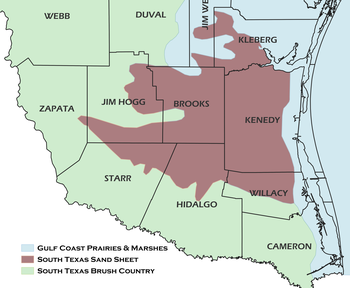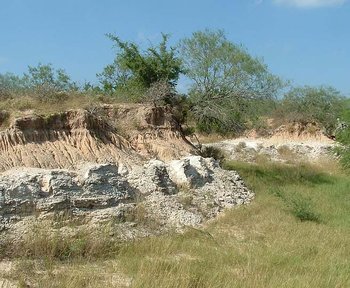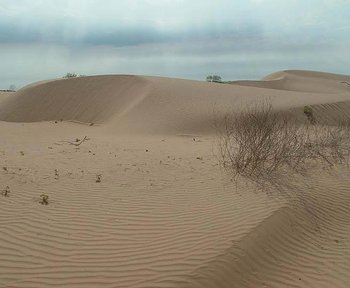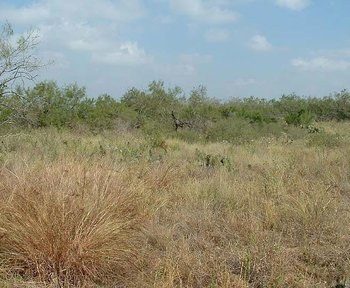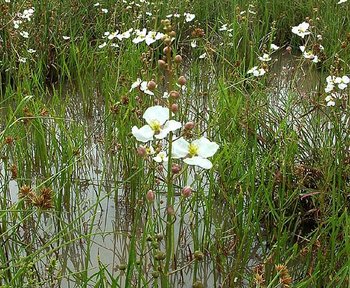Some Plants of the South Texas Sand Sheet
The South Texas Sand Sheet, also known as the Coastal Sand Plains and the Llano Mesteño, occupies more than two million acres at the southern tip of the state, just north of the Lower Rio Grande Valley. The region is defined by a sheet of eolian sand blown inland from the shoreline of the Gulf of Mexico during Holocene times, a sheet that covers most of Kenedy and Brooks counties as well as the northern tips of Willacy, Hidalgo and Starr counties. Although most maps place the western edge of the sand sheet in Jim Hogg County, isolated patches of Holocene sand are mapped within a few miles of the Rio Grande in northwestern Zapata County (Brewton et al., 1976) and are included for the purposes of this discussion. The eastern edge is somewhat arbitrary. Laguna Madre separates the Sand Sheet from modern barrier islands along the Gulf of Mexico, but there is no clear boundary between the Sand Sheet and the Flour Bluff Peninsula, a Pleistocene barrier island situated west of Laguna Madre in southern Nueces County.
Topography in the region is generally flat. Most parts of the sand sheet are a base-level plain with very little relief. Other parts, particularly those closer to the coast, are covered in active or stabilized dunes oriented along a northwest-southeast axis. Relief is greatest in Kenedy County, where some dunes west of Laguna Madre are as much as 50 feet tall. Elevation in the region ranges from near sea level in the east to about 800 feet near Hebbronville in the west. Drainage systems are limited, and the few wet-weather streams that arise in the western highlands typically terminate in miscellaneous lowlands rather than in Laguna Madre or the Gulf of Mexico. In flatter parts of the landscape, rainwater simply collects in and evaporates from small roundish potholes or copitas; in active dune fields, elongate swales are more common. Most of these wetlands are seasonal or intermittent, but a few are permanent. Most contain fresh water, but those lying along established drainageways lowest on the landscape tend to be saline. Lomas or clay dunes have developed on the downwind (northwest) side of larger ephemeral saline ponds.
Soils of the region are generally sandy. Characteristic soils of dune fields are light-colored, deep to very deep, well drained to excessively drained, neutral to slightly acid fine sand Alfisols and Psamments. Soils of planar areas are typically light brown, deep, moderately well drained to well drained, slightly acid fine sand Alfisols. In some areas, particular where the wind-blown sand is a thin veneer over calcareous sandstone and caliche of the Goliad Formation, typical soils are reddish-brown, well drained, neutral fine sandy loam Alfisols (Sanders et al., 1974; Thompson, 1972; Williamson, 1993). Soils of lomas are mapped as very deep, friable, dark grayish brown, calcareous, moderately alkaline fine sandy loam Mollisols.
Climate in the area is considered to be humid subtropical, with hot summers and mild winters. Mean annual precipitation ranges from 20 inches in Zapata County to 30 inches in Kenedy County. The average growing season ranges from 304 days in Zapata County to 319 days in Kenedy County (Natural Fibers Information Center, 1987).
Most of the South Texas Sand Sheet is dedicated to the production of cattle and huntable wildlife. Even in the 21st Century it is a region of very large ranches and very few people. The King Ranch, for example, occupies 825,000 acres, mostly in Kenedy County, and the estimated population of Kenedy County in 2003 was 408 persons (Dallas Morning News, 2004).
Several matrix-level vegetation types can be recognized within the South Texas Sand Sheet. One type is a live oak (Quercus sp.) woodland that covers much of the dune topography in eastern Kenedy County and extends patchily westward. The nominative oak is said to be Quercus fusiformis. Other components of these woodlands include toothache-tree (Zanthoxylum hirsutum), honey mesquite (Prosopis glandulosa) and brasil (Condalia hookeri). Associated with this woodland is a tallgrass grassland dominated by seacoast bluestem (Schizachyrium scoparium var. littorale) and gulfdune paspalum (Paspalum monostachyum), with camphor daisy (Heterotheca subaxillaris) and other forbs more common on sand ridges (Diamond & Fulbright, 1990). Other important components of the grassland include brownseed paspalum (Paspalum plicatulum), crinkleawn (Trachypogon secundus), Indiangrass (Sorghastum nutans) and big bluestem (Andropogon gerardii) (Diamond & Fulbright, 1990).
Another major vegetation type in the region is honey mesquite woodland, which is found on light brown fine sands and reddish-brown sandy loams of plains. In such situations, mesquite typically occurs with colima or lime prickly ash (Zanthoxylum fagara), brasil, prickly pear (Opuntia spp.) and other thorny shrubs. Associated with this woodland is a midgrass grassland composed of lovegrasses (Eragrostis spp.), three-awns (Aristida spp.), fringed signalgrass (Urochloa ciliatissima) and other species. The balance between the grassland and woodland components may have been influenced by historic cattle grazing.
Wetlands are common, although most are small and ephemeral. Deeper freshwater ponds and swales in the eastern part of the region have a well developed florula, with spikesedges (Eleocharis cellulosa, E. palustris and E. quadrangulata) often dominant. Other conspicuous components include arrowhead (Sagittaria longiloba), elegant waterlily (Nymphaea elegans), yellow-eyed grass (Xyris jupicai) and jointed flatsedge (Cyperus articulatus). Shallower freshwater ponds in the western part of the region, or ponds that are actively grazed, usually have shorter vegetation consisting of short sedge species (Eleocharis parvula, E. minimus and Schoenoplectus saximontanus) and burheads (Echinodorus berteroi and E. tenellus). Salt or brackish ponds typically have extensive open water rimmed by saline clay supporting sparse cover of a few halophytes, notably shoregrass (Monanthochloe littoralis) and white spikesedge (Eleocharis albida).
Also low on the landscape, mostly along drainageways near the coast, are bands of saline soils that support a variety vegetation types. One type is a short-stature shrubland typified by Drummond goldenweed (Isocoma drummondii), amargosa (Castela erecta ssp. texana), gutta percha (Maytenus phyllanthoides), dwarf screwbean (Prosopis reptans), rubberstem (Jatropha dioica), horse-crippler cactus (Echinocactus texensis), pricklypear and stunted honey mesquite. Associated grasses include alkali sacaton, (Sporobolus airoides) and whorled dropseed (Sporobolus pyramidatus). Also present are grasslands dominated by gulf cordgrass (Spartina spartinae).
Other localized vegetation types are medium-stature shrublands that occur on slopes of the region's few major drainageways, often where the underlying calcareous sandstone of the Goliad Formation is exposed, and on lomas upwind from salt lakes. These communities include many shrub species that are more commonly found in Tamaulipan thornscrub to the south and west. Patterns in these shrublands have not yet been discerned.
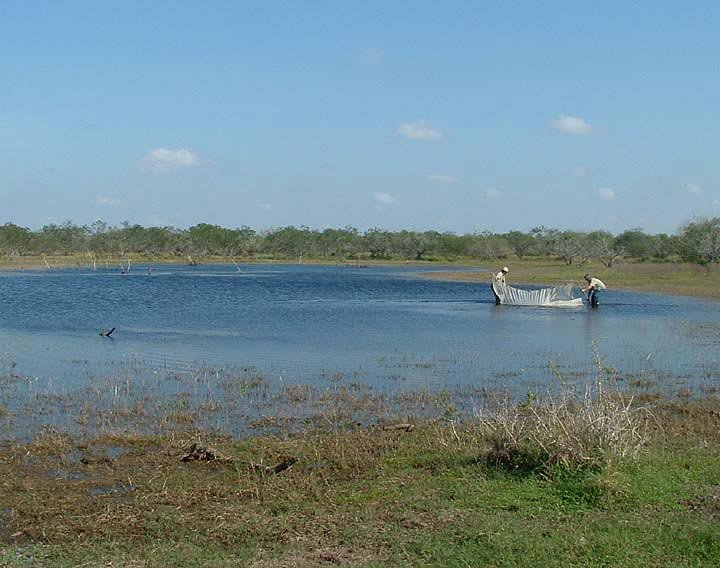
- Abronia ameliae — amelia sandverbena
- Allium elmendorfii — Elmendorf's onion
- Allium runyonii — Runyon's onion
- Brazoria arenaria — sand brazosmint
- Coreopsis nuecensis — crown tickseed
- Coreopsis nuecensoides — Rio Grande tickseed
- Croton argyranthemus — silverleaf croton
- Croton capitatus — woolly croton
- Croton coryi — Cory's croton
- Croton glandulosus — vente conmigo
- Croton parksii — Parks' croton
- Cryptantha texana — pick me nots
- Dalea austrotexana — dune dalea
- Dalea obovata — pussyfoot
- Ditaxis pilosissima — pilose wild-mercury
- Galactia canescens — hoary milkpea
- Galactia heterophylla — Gray's milkpea
- Helianthus praecox var. runyonii — Runyon's sunflower
- Houstonia croftiae — Croft's bluet
- Houstonia subviscosa — nodding bluet
- Lechea san-sabeana — San Saba pinweed
- Lesquerella grandiflora — bigflower bladderpod
- Liatris carizzana — pinkscale gayfeather
- Lupinus subcarnosus — Texas bluebonnet
- Matelea parviflora — smallflower milkvine
- Monarda fruticulosa — spotted beebalm
- Palafoxia hookeriana — showy palafoxia
- Paronychia jonesii — Jones' nailwort
- Paronychia lundellorum — Lundells' nailwort
- Phacelia congesta — blue curls
- Phacelia patuliflora — sand scorpionweed
- Phyllanthus abnormis — abnormis leaflower
- Polanisia erosa ssp. breviglandulosa — large clammyweed
- Prunus texana — Texas peachbrush
- Senecio ampullaceus — Texas ragwort
- Sphaeralcea lindheimeri — woolly globemallow
- Tephrosia lindheimeri — goat's rue
- Tetragonotheca repanda — showy nerveray
- Thelesperma nuecense — Rio Grande greenthread
- Vaseyochloa multinervosa — Texasgrass
Asterisks indicate those taxa that are essentially endemic to the South Texas Sand Sheet
Many people graciously provided access to the properties on which most of the photographs on these pages were taken. Special thanks are owed to Monica and Ray Burdette, El Canelo Ranch; Steve and Toddy Burns, Encinitos Ranch; Dr. Lester Dyke, Long Rifle Ranch; Guerrero family, Las Comitas; Mrs. Luella Hauser, Charco Salado Ranch; Hunke family, El Tecolote Ranch; Kipp Layton, Eshleman-Vogt Ranch; Paul and Patti Pauley, San Rodolfo Ranch; Bud Payne, Payne Ranch; Betta Thomas, Thomas Ranch; Armando Vela, Vela ranches; and Lisa Williams and Sonia Najera of The Nature Conservancy.

